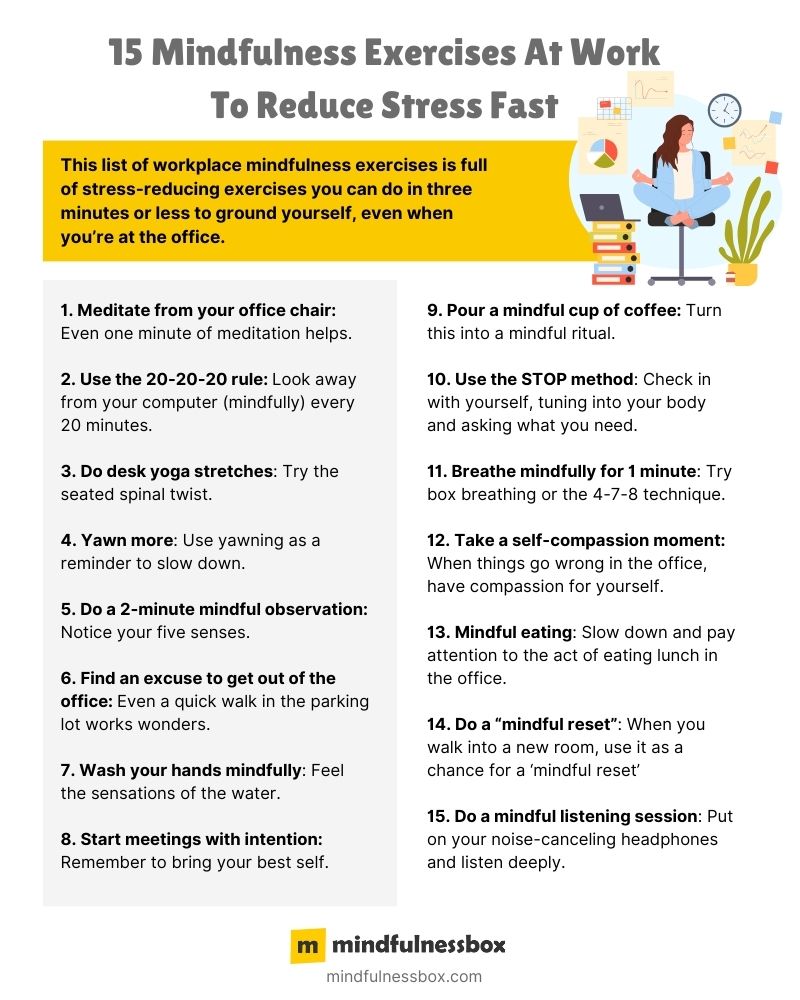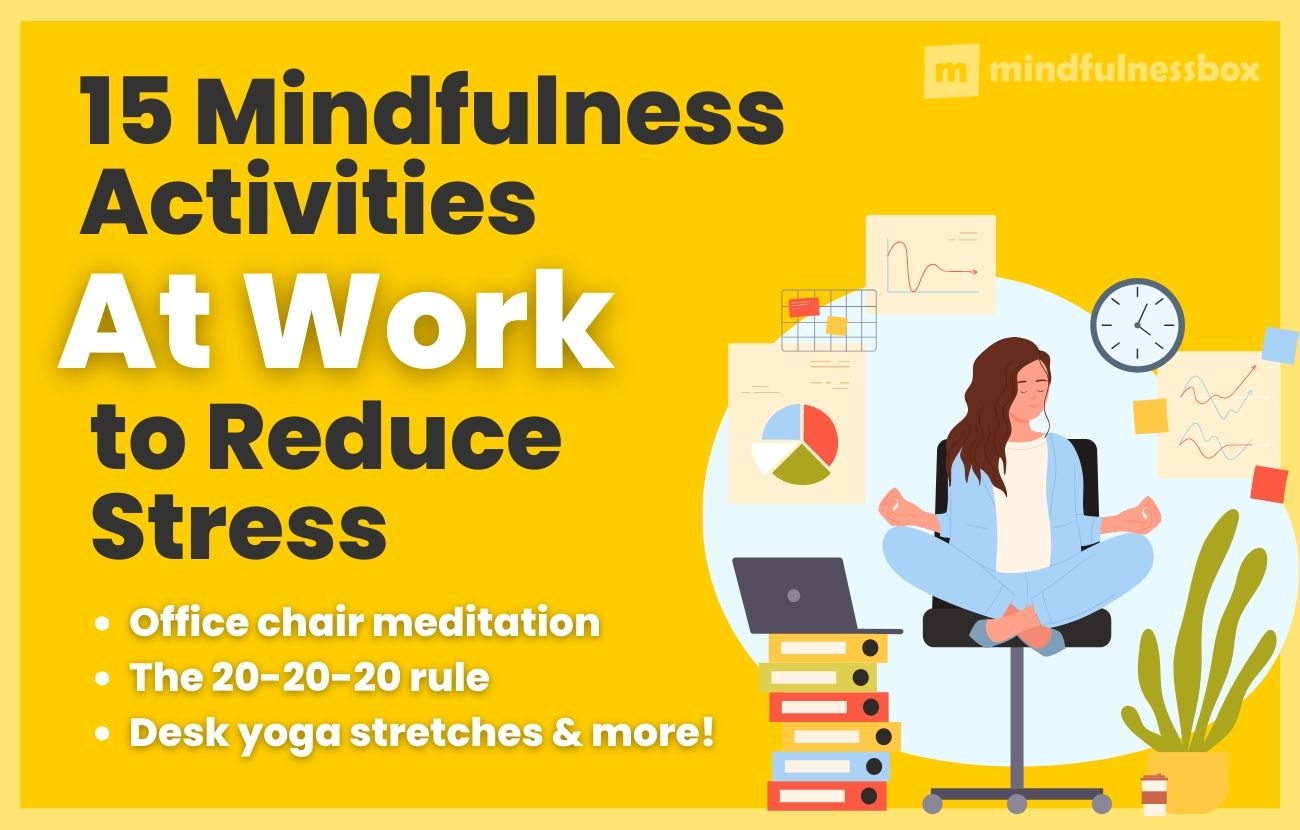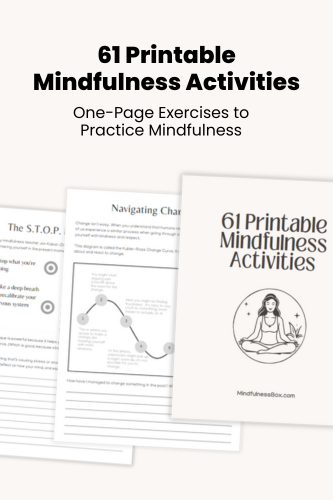Mindfulness exercises at work have a few requirements: you need to be able to do them in a professional environment; they need to be quick; and they need to be simple enough to remember them when you need them. This list of workplace mindfulness exercises is full of stress-reducing exercises you can do in three minutes or less to ground yourself, even when you’re at the office.
A 2022 report found that 2-3% of workers suffer from work-related stress, anxiety, or depression. According to the Business Group on Health, a majority of companies are now attempting to combat this trend by teaching mindfulness skills to employees.
But be honest: how often do you see colleagues turning off their computer monitors, pulling out a meditation cushion, and going Zen in their cubicle?
Get dozens of one-page exercises to help practice mindfulness, meditation, gratitude, and self love. Perfect for printable handouts when teaching mindfulness to groups, students, or in the workplace.
To see examples, plus a full list of the 61 exercises included, click below.
Some workplaces encourage this (as they should), but the structure and culture of many office environments leads employees to look for other outlets for mindfulness.
The goal of this list is to offer workplace mindfulness exercises that can be done quickly, while giving you the recharge time and stress reduction you need to make it through the day as a calmer, happier version of you.
15 ideas for mindfulness exercises at work
Let’s explore some specific work mindfulness activities below.

1) Meditate right from your office chair
Alright, let’s first address the cubicle-sized elephant in the room:
Many of us are desk-bound at work.
(Not every workplace, sadly, has a meditation room or the flexibility to take nature walks).
But here’s the good news:
Doing sitting meditation while in your office chair works just as well.
Put your feet flat, sit comfortably in your chair with good posture, close your eyes and focus on your breathing. As your mind wanders away from your breath, gently bring it back.
This mindful observation exercise can be done in the middle of the workday when you have 60 seconds to yourself.
If you’d like something more structured, put on your headphones and try a guided meditation.
Some mindfulness apps offer guided meditations that are as short as one minute.
For example, here’s a one minute meditation from Insight Timer, that lets you “take a serenity break for one minute.”
Quick meditation exercises like this have the potential to help you switch to a more mindful frame of mind in just 60 seconds.
2) Use the 20-20-20 rule
You might have heard your optometrist talk about the 20-20-20 rule. (It’s actually intended to prevent eye strain.)
It goes like this:
- Every 20 minutes, look away from your computer screen
- Focus on something at least 20 feet away
- Do this for 20 seconds.
But beyond just being a vision care practice, the 20-20-20 rule offers a golden opportunity for practicing mindfulness throughout the workday.
Those 20 seconds are a brief but invaluable window to reconnect with the present moment (while taking care of your eyes and lowering your chances of a computer-induced headache).
As you consciously engage with your surroundings, let go of the mental clutter, inviting a sense of calm and clarity to wash over you.
3) Take a break for desk yoga
No, you don’t have to do downward dog in your cubicle. (Although I fully support that!).
There’s a quicker, less noticeable way to connect with your inner yogi at the office:
Desk yoga stretches.
Taking a moment for desk yoga can be a game-changer for both your mental and physical well-being. It’s a quick and effective way to alleviate stress and re-energize, right from the confines of your office chair.
Here are two simple but powerful yoga stretches for your desk-bound moments.
Two desk yoga stretch techniques:
- Neck and Shoulder Release: Inhale and as you exhale, gently tilt your head to the right, bringing your ear close to your shoulder. Hold for a few breaths, feeling the stretch along the left side of your neck. Repeat on the other side. To release tension in your shoulders, inhale, bring your shoulders up towards your ears, hold for a moment, and then exhale and let them drop down. Repeat a few times.
- Seated Spinal Twist: Sit up tall, exhale, and twist your torso to the right, placing your left hand on your right knee and your right hand on the back of your chair. Hold the twist for a few breaths, feeling the lengthening of your spine. Inhale to the center, then exhale and twist to the left. This stretch is excellent for releasing lower back tension.
4) Yawn deeply, then stretch
If you’re like me, yawning starts kicking in around the middle of the afternoon.
Instead of avoiding these yawns during the workday, lean into them! Let your body’s automatic processes take over. Slow down, letting the yawn interrupt your normal thought processes.
Take the opportunity to stretch while you yawn—slowly, for 20 seconds, holding the stretch longer than you think you need to. Notice any areas of your tightness in your body, and ease them into relaxation. Then, take a few moments to come back to reality, setting the intention to be present.
Notice how the brief pause that comes from yawning feels.
You don’t have to wait for yawns to come naturally. You can also start by faking a yawn. It may feel funny, but a fake yawn will lead to real ones later.
5) Take two minutes of mindful observation
This one is best done sitting or standing outside the office. If you can get exposed to a little nature, in a nearby garden or park, all the better. But if needed, you can also observe from within your office.
Take a couple minutes to check in with your five senses.
What does it feel like to you be right now, in whatever environment you find yourself in? Can you feel the wind against your skin? How about the area around you – what does it smell like? Are there birds, and are they singing?
Done with enough intention, you’ll get a taste of mindfulness in a minute from wherever you’re sitting.
6) Find an excuse for a mindful out-of-office break
Even if you love your office and the people you work with, short breaks outside are essential for overall well-being and productivity.
Whether it’s a short walk around the block, finding a quiet spot in a nearby park, or simply sitting by a window and observing the world outside, getting your head out of the office environment is a vital chance to recharge.
In my last office job, I used to leave the office and walk around the parking lot in the sun, or drive to get a coffee just for a change in environment.
During these moments, focus on your breathing, observe the surroundings without judgment, and let go of any accumulated tension. Embracing these mindful breaks not only enhances creativity and problem-solving but also ensures you return to your tasks with a refreshed mind and a renewed sense of purpose.
7) Wash your hands mindfully
Some mindfulness exercises are hard.
Washing your hands mindfully is not one of them.
All it requires, honestly, is remembering the intention to do it. If you can build the habit of mindful hand washing, you’ll find yourself with built-in mindfulness opportunities at least 3-5 times per day.
Here’s how it works:
When you get to the sink to wash your hands and see yourself in the mirror, set the intention for that to be a trigger to come back to the present.
Slowly turn on the tap, feeling the temperature of the water. Lather soap onto your hands with care, rather than quickly. Then slowly rinse your hands, and turn the tap off.
The key is to linger on each part of this process, noticing how it feels to turn an everyday, automatic activity into something you truly give your attention to.
8) Start meetings with intention
If you run meetings at your office, you’ve got a chance to create a moment of mindfulness not just for yourself, but for others in the meeting.
Meetings aren’t just about the topics at hand.
They’re also, perhaps more importantly, about the people in the meeting.
Go into the meeting with the intention to check in with others and to make them feel heard. Remember that this is a chance not only to get on the same page about work issues, but to connect on a human level with others. Begin with a positive tone, and foster a mindful atmosphere that allows others to calmly and meaningfully engage.
For example, you may go into your meeting with this intent: “I am going to radiate joy and be contagiously positive to those around me today. I am going to make their lives better by being around me.” Or even simply, “Today, I choose to treat everyone I encounter with kindness and respect.”
If you want to bring more overt elements of mindfulness into your meetings, and others are comfortable with that too, then by all means do so. Moments of silence and grounding exercises are a good place to start.
9) Pour a mindful cup of coffee or tea
Getting a cup of coffee or hanging by the water cooler is a timeless water ritual.
When you need coffee or run out of water, take advantage of the opportunity this opens up for mindfulness.
Let’s take the simple act of making coffee or tea as an example:
Instead of hurriedly preparing your beverage, approach the process with awareness and appreciation. Feel the warmth of the mug against your palms, inhale the aroma deeply, and savor the taste with each sip. Allow this experience to be a moment of tranquility amid the workday chaos, grounding yourself in the present.
By filling your coffee, tea, and water errands with mindful meaning, you not only enhance your sensory awareness but also infuse your day with small, delightful moments of mindfulness.
10) Use the STOP method
The STOP method is an easy-to-remember mnemonic that helps you slow down and tune into yourself, your feelings, and your body. You can do it in as little as a minute.
Here’s how it works.
The STOP method:
(S) Stand up and breathe.
(T) Tune into your body. See how it feels. Notice that it’s connected to the Earth. Notice any physical sensations.
(O) Observe. What physical sensations do you have? Are they positive, or negative?
(P) Possibility. Ask yourself what is possible in this moment. Can this be a turning point for the rest of the day?
11) Breathe mindfully for one minute
Take a moment, wherever you are, to breathe consciously and mindfully.
Breathing is an automatic process, but to really pay attention to it is a different experience.
First, lower your eyes, and notice where your breath is. Perhaps it’s in your nostrils, or maybe you feel it more in your stomach, or your chest. Second, breathe a little deeper and longer than you usually do. Notice how it feels. Third, when your mind wanders away from focusing on breathing (as it tends to do), gently come back to your breath.
4-7-8 breathing is one popular technique:
4-7-8 breathing
The 4-7-8 breathing technique is intended to calm your nervous system, and provide a mindful moment through the experience of breathing.
It’s a powerful, easy-to-remember 1 minute meditation.
Make yourself comfortable while sitting or lying down, then breathe through your nose for 4 seconds. Hold your breath for 7 seconds, then breath forcefully out for 8 seconds.
In one minute, you can do three cycles of 4-7-8 breathing.
Box breathing is another:
Box breathing
Box breathing is similar to 4-7-8 breathing, but shorter, and includes a visualization exercise to simplify things.
- Start by visualizing the left side of a two-dimensional square, and inhale to the count of 4. As you inhale, head to the top of the square in your mind’s eye.
- Then, hold your breath for 4 seconds, heading towards the right side of the square.
- Exhale for 4 seconds, heading down the right side of the box.
- Then hold for another 4 seconds at the bottom of the box, before starting the process again.
You can do as many as four rounds of box breathing in one minute.
12) Take a moment for self-compassion
It can be easy to beat yourself up for mistakes in the course of the workday. “I should have done this; I wish I’d done that. I should be more responsible. How could I let that happen?”
Self-compassion is a way to treat yourself like you would treat a dear friend. In just one minute, the CAN mnemonic can help you show yourself compassion.
Here’s how it works.
The CAN method
(C) it’s Common to feel like this. In the first step, you reassure yourself that everyone has moments like this.
(A) bring Awareness to your breath and your body. Ground yourself.
(N) be Nurturing to yourself. Place your hand on your heart, or give yourself a hug. Tell yourself, “It’s okay. You’re okay. It’s normal to feel the way you’re feeling. This will pass.”
13) Mindful eating
Many offices are filled with workers scarfing down lunch as quickly as possible so they can get back to their desks. (And, of course, there are those who eat lunch at their desk, which I’ve been guilty of plenty of times in the past).
Suffice it to say, offices are not the most natural place for mindul eating.
But what if you did eat your lunch mindfully in the office? What would that look like? How would that mindful pause affect the rest of your day?
Mindful eating questions to keep in mind:
In the middle of a meal, check in with yourself and notice how you’re eating. Are you eating quickly? Are you paying attention to the texture and flavor of the food and drink?
It’s easy to eat automatically instead of mindfully. When you catch yourself doing this, it may be a good time to take a mindful eating minute. Take a piece of food and savor it, noticing how it tastes and smells. Eat slower than normal, and notice how the meal feels as you slow down.
14) Find ways to do a “mindful reset”
How many doors are there in the office you work in? How many different rooms?
What if each of those doorways served as a reminder to “reset” and come back mindfully, with intention, to your most authentic self?
This technique was developed by Jan Chozen Bays, author of a mindfulness book called How to Train a Wild Elephant.
Here’s how it works:
When you walk through a door and enter a new space, use that moment as a trigger to remind yourself you want to be mindful.
Pause, take one breath, and be aware of the differences between the space you left, and the space you are now entering. Then, continue.
15) Put on your headphones and tune out the world for 3 minutes
Noise-canceling headphones are the open-plan office worker’s best friend.
If you’ve got a few minutes, plug in your headphones, tune out the rest of the office, and put on a song.
It could be music you know, or something you’ve never heard before. Either way,
Choose a piece of music you’ve never heard before, and set an intention to really listen to it: the feeling of the song, the instruments involved, the intention behind the words.
Here’s one strategy:
Pick out one instrument among the many that you hear, and see if you can follow along with it separately, rather than letting it blend in with all the others.
Listen nonjudgmentally and without expectation.

My mindfulness practice kicked off in 2016 with a ten-day silent retreat. Since then, I’ve read dozens of books about mindfulness and completed hundreds of hours of meditation. Thinking about what makes humans happy, calm, and peaceful is endlessly fascinating to me.


